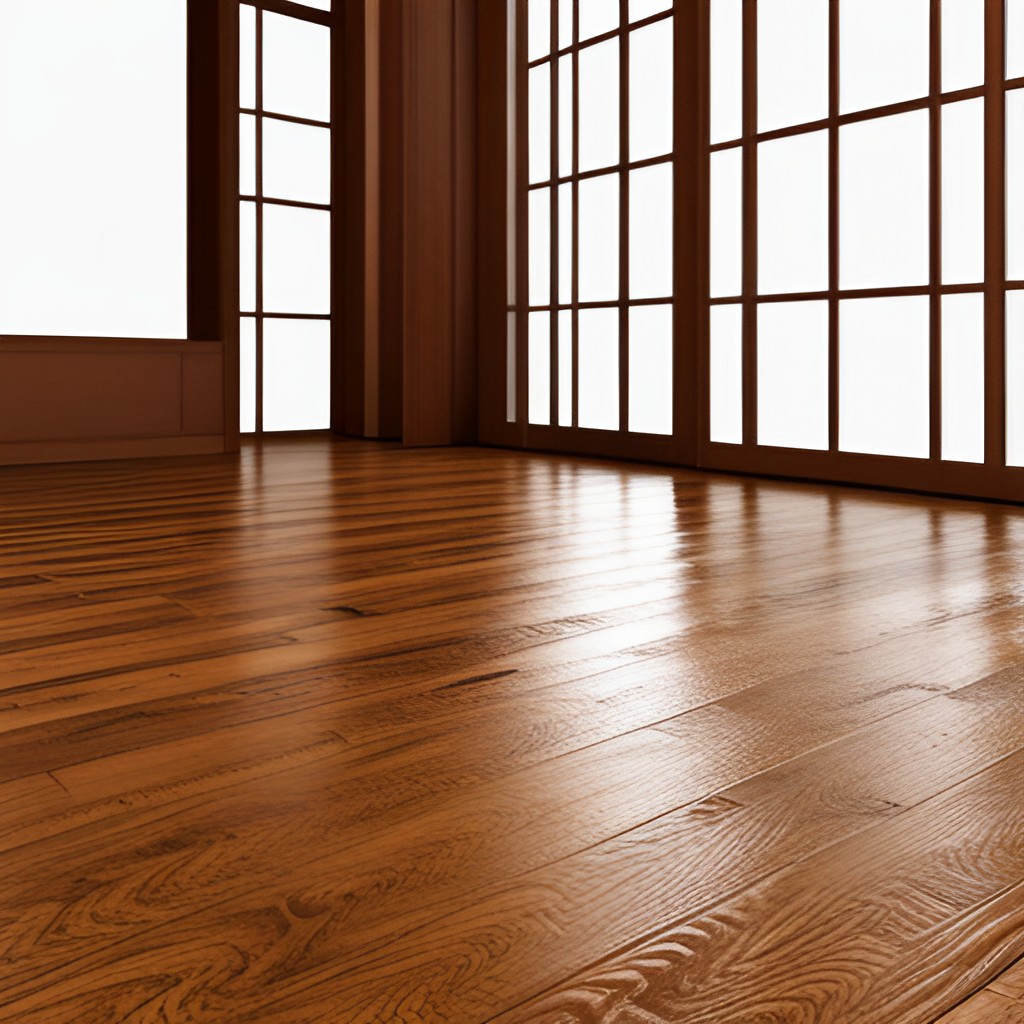Sustainability in the context of flooring materials refers to practices and choices that contribute to the long-term health of our environment, economy, and society. This encompasses the entire lifecycle of the material, from sourcing and manufacturing to installation, maintenance, and eventual disposal or reuse.
Sustainable flooring materials are those that minimize negative environmental impacts by using renewable resources, avoiding toxic chemicals, and ensuring ethical labor practices.
They are designed to be durable, reducing the need for frequent replacement, thereby conserving resources and reducing waste. Additionally, sustainable flooring materials should contribute to a healthy indoor environment, free from harmful emissions and pollutants.
When it comes to oak flooring, these criteria are essential in determining whether it can be considered a sustainable option.
Overview of Oak Flooring

Oak wood is renowned for its strength, durability, and timeless aesthetic appeal, making it a highly sought-after material in flooring.
Oak has a tight, dense grain that provides excellent resistance to wear and impact, ensuring longevity even in high-traffic areas. Its natural hues range from light golden tones to rich, warm browns, which can complement a variety of interior design styles.
Oak flooring is also receptive to different stains and finishes, allowing homeowners to customize its appearance to their preferences.
Commonly used in residential and commercial spaces, oak flooring’s popularity stems from both its practical and visual attributes. Its ability to withstand heavy foot traffic without significant deterioration makes it a preferred choice for living rooms, hallways, and offices.
Moreover, oak’s natural grain patterns and colors imbue spaces with a sense of elegance and sophistication, enhancing the overall aesthetic of any room.
The enduring appeal and robust nature of oak wood have cemented its place as a classic and reliable flooring choice.
Environmental Impact of Oak Harvesting

Methods of Oak Wood Harvesting
The methods of oak wood harvesting play a crucial role in determining the sustainability and environmental impact of oak flooring. There are several prevalent techniques used to harvest oak wood, each with distinct implications for the forest ecosystem.
Selective Cutting
Selective cutting involves the careful selection and removal of only certain trees, typically those that are mature and ready for harvest. This method minimizes damage to the surrounding forest, as it allows younger trees to continue growing and maintains the overall structure of the ecosystem.
By leaving a healthy mix of tree ages and species, selective cutting promotes biodiversity and forest regeneration.
Shelterwood Cutting
Shelterwood cutting is a method that involves removing trees in phases over some time. Initially, a portion of the mature trees is harvested, which allows light to penetrate the forest floor, encouraging the growth of seedlings and understory plants.
As the new generation of trees establishes itself, additional phases of cutting occur, gradually removing the remaining mature trees. This method ensures continuous forest cover and facilitates a smooth transition between tree generations.
Clear-Cutting
Clear-cutting involves the removal of all trees in a designated area, often leading to significant environmental disruption. While this method is efficient and cost-effective, it can result in soil erosion, loss of habitat, and diminished biodiversity.
Clear-cutting is generally considered less sustainable and has a more pronounced negative impact on the forest ecosystem compared to selective and shelterwood-cutting methods.
Sustainable Forest Management
To mitigate the environmental impact of oak harvesting, sustainable forest management practices are implemented. These practices include adhering to certifications and standards such as the Forest Stewardship Council (FSC) and the Programme for the Endorsement of Forest Certification (PEFC).
These certifications ensure that the wood is sourced responsibly, with attention to conserving biodiversity, protecting water resources, and respecting the rights of indigenous communities.
Each method of oak wood harvesting affects the forest differently, and responsibly choosing sustainable practices is essential in maintaining the ecological balance and ensuring the long-term availability of oak resources for future generations.
Impact on Forests and Ecosystems

The type of oak wood harvesting method employed has significant and far-reaching impacts on forests and ecosystems. Selective cutting, for instance, maintains a semblance of the natural forest structure and biodiversity, allowing for continued wildlife habitats and minimizing soil erosion.
The strategic removal of specific trees supports sustained ecosystem functions and promotes the growth of understory vegetation, which is crucial for maintaining soil health and overall forest resilience.
In contrast, clear-cutting can lead to substantial ecological disruptions. The complete removal of tree cover exposes the soil to erosion by wind and water, depletes soil nutrients, and disrupts water cycles.
This method drastically reduces habitat diversity, endangering species reliant on the forest for shelter and sustenance.
Loss of biodiversity is not only a risk to wildlife but also impairs the forest’s ability to recover and regenerate naturally, potentially leading to long-term ecological degradation.
Sustainable forest management practices seek to mitigate these negative impacts by incorporating conservation principles into harvesting operations.
Adhering to FSC and PEFC standards ensures that oak wood harvesting is conducted to preserve biodiversity, protect critical water resources, and maintain the social and cultural values of forests.
Economic Implications

Clear-cutting and selective logging are two fundamentally different forest management practices with distinct impacts on the environment and ecosystem health.
Clear-cutting involves the removal of all trees in a designated area, which can lead to severe soil erosion, loss of biodiversity, and disruption of water cycles.
This method simplifies forest structure, making it more challenging for the ecosystem to recover naturally and support diverse wildlife habitats.
On the other hand, selective logging targets specific trees for removal, thereby maintaining the overall forest structure and biodiversity. This practice enables the preservation of habitats, reduces soil erosion, and promotes the growth of a variety of plant species.
Selective logging is generally more sustainable, as it supports ecosystem resilience and soil health, ensuring the regeneration of forests over time.
Resource Management Practices
Sustainable Forestry Practices

Sustainable forestry practices involve a set of management techniques aimed at preserving the health and biodiversity of forests while meeting the needs of present and future generations.
These practices include selective logging, controlled burns, and the protection of old-growth forests.
By focusing on minimizing environmental impacts, sustainable forestry helps maintain the ecosystem’s balance, supports wildlife habitats, and ensures the long-term availability of forest resources.
Certification Programs
Certification programs like the Forest Stewardship Council (FSC) and the Programme for the Endorsement of Forest Certification (PEFC) play a pivotal role in promoting sustainable forestry.
These programs set stringent standards for forest management, ensuring that wood and paper products come from responsibly managed forests that provide environmental, social, and economic benefits.
Certified forests undergo regular audits to verify compliance, providing consumers and businesses with credible responsible sourcing options.
Government Regulations
Government regulations and conservation efforts are essential components of sustainable forestry. Environmental laws and policies often mandate practices like reforestation, habitat protection, and the restriction of harmful logging techniques.
Governments may also fund conservation projects and research initiatives aimed at enhancing forest health and resilience.
By enforcing regulations and supporting conservation, governmental bodies help safeguard forests against over-exploitation and degradation.
Related Topics:
Carbon Footprint

Emissions from Oak Flooring
The production of oak flooring entails substantial emissions of greenhouse gases. The process begins with the logging of oak trees, which releases carbon stored in the biomass into the atmosphere.
Following this, the milling and processing stages consume significant amounts of energy, typically derived from fossil fuels, contributing further to carbon dioxide emissions.
Moreover, the drying and finishing steps involve the use of chemical treatments that emit volatile organic compounds (VOCs), exacerbating environmental pollution.
Transportation Impact
Transportation of oak flooring materials from forests to processing plants, and subsequently to marketplaces, imposes an additional environmental toll. The reliance on heavy-duty trucks and shipping containers, often powered by diesel fuel, results in high emissions of carbon dioxide and other pollutants.
This transportation network’s extensive carbon footprint underscores the need for considering local sourcing and more eco-friendly logistics options to mitigate adverse environmental impacts.
Comparison with Alternatives
When compared to alternative flooring materials such as bamboo and cork, oak flooring exhibits a higher carbon footprint. Bamboo, a rapidly renewable resource, regenerates much faster than oak and often requires less energy for processing.
Similarly, cork is harvested from the bark without killing the tree, allowing for continuous growth and carbon sequestration.
These alternatives generally have lower greenhouse gas emissions across their life cycles, making them more sustainable options for environmentally conscious consumers.
Lifespan and Durability

Longevity
Oak flooring is renowned for its remarkable longevity, often outlasting other flooring materials such as vinyl and laminate. With proper care, oak floors can maintain their aesthetic appeal and structural integrity for decades, sometimes even a century.
This extended lifespan makes oak a durable choice that can withstand the test of time and heavy foot traffic. In contrast, materials like vinyl and laminate may require more frequent replacements, contributing to increased waste and environmental impact.
Maintenance
Maintaining oak flooring requires regular cleaning and occasional refinishing to preserve its appearance and functionality. Simple practices like sweeping or vacuuming to remove dirt and debris can prevent scratches and wear.
Periodic refinishing not only revives the wood’s beauty but also shields it from future damage, thereby extending its lifespan.
In comparison, while bamboo and cork flooring also demand upkeep, they can sometimes be more susceptible to moisture and physical damage, necessitating more frequent interventions.
Refinishing
One of the standout features of oak flooring is its potential for refinishing multiple times throughout its life. This capability allows homeowners to renew the wood’s surface, eliminating imperfections like scratches and dents, and even altering the stain color to match changing interior design preferences.
The ability to refinish greatly enhances oak flooring’s sustainability by avoiding premature replacement and reducing resource consumption.
Unlike oak, materials like laminate and vinyl generally lack the capacity for refinishing, making their longevity inherently limited.
Waste Management
Recycling and Disposal

Recycling oak flooring is a viable option that contributes significantly to sustainable waste management. When oak flooring reaches the end of its life cycle, it can be collected, processed, and repurposed, reducing the demand for new raw materials and minimizing waste.
Proper disposal methods involve taking the wood to specialized recycling centers where it can be transformed into composite materials, mulch, or even bioenergy.
This approach ensures that the value of the wood is maintained within the production cycle, decreasing the environmental footprint associated with flooring waste.
Upcycling Potential
Used oak wood possesses substantial upcycling potential, enabling creative repurposing into new products. This versatile material can be transformed into a variety of items such as furniture, wall panels, or decorative pieces.
By upcycling, homeowners and businesses can give the wood a new lease on life, preserving its natural beauty and durability while reducing the need for virgin materials.
This practice not only extends the material’s usability but also fosters innovation and creativity in design and construction, providing a sustainable solution to material waste.
Impact on Landfills
The improper disposal of oak flooring significantly impacts landfills, contributing to material build-up and long-term environmental degradation. As oak is a natural, biodegradable material, its presence in landfills does contribute to methane emissions during decomposition.
However, the sheer volume of discarded flooring materials can strain landfill capacity and hinder waste management systems.
Implementing effective recycling and upcycling strategies can substantially mitigate these impacts, ensuring that oak flooring waste is managed in an environmentally responsible manner.
Economic and Social Considerations
Cost Analysis
Evaluating the cost implications of sustainable oak flooring involves examining initial investment compared to long-term savings. Sustainable options may have higher upfront costs due to the use of certified materials and environmentally friendly processes.
However, these costs can be offset by the durability and low maintenance needs of sustainably sourced oak, which extend the flooring’s lifespan and reduce replacement frequencies.
Community Impact
The adoption of sustainable oak flooring can significantly benefit local communities. By sourcing oak from responsibly managed forests and supporting local manufacturers, communities can sustain local economies and promote job creation.
It fosters a sense of environmental stewardship and can lead to educational opportunities centered around sustainability practices.
Financial and Social Benefits
Sustainable practices in oak flooring not only contribute to financial gains through cost efficiency and extended product life but also yield numerous social advantages.
These practices preserve natural resources for future generations, promote healthier living environments by reducing harmful emissions, and build community resilience through sustainable economic development.
Consequently, the integration of sustainable oak flooring practices supports a balanced approach to economic viability and social responsibility.
Consumer Choices and Best Practices
Guidelines for Choosing
When selecting sustainable oak flooring, prioritize products that demonstrate a clear commitment to environmental stewardship. Investigate the sourcing practices of the wood, ensuring it comes from responsibly managed forests.
Opt for manufacturers that are transparent about their sustainability efforts and actively engage in reducing their environmental footprint.
Certification Labels
Look for certification labels that guarantee sustainability, such as FSC (Forest Stewardship Council) or PEFC (Programme for the Endorsement of Forest Certification).
These labels ensure that the wood has been harvested in an environmentally responsible, socially beneficial, and economically viable manner. By choosing certified products, you contribute to the protection of forest ecosystems and the promotion of responsible forestry practices.
Supporting Sustainable Businesses
Supporting businesses committed to sustainability extends beyond the benefits it provides to the environment. These companies often lead in innovative practices, ensuring minimal waste and reduced emissions.
By purchasing from eco-friendly brands, you help foster market demand for sustainable products, encouraging more companies to adopt ethical practices and thereby contributing to the broader movement towards environmental conservation.
Conclusion
Choosing sustainable oak flooring begins with understanding the importance of sourcing from responsibly managed forests and seeking transparency in the manufacturing process.
Certification labels like FSC and PEFC serve as a reliable assurance of sustainability, promoting environmentally responsible and economically viable practices.
Supporting businesses dedicated to eco-friendly practices not only benefits the environment but also encourages market-wide adherence to ethical standards.
Sustainable oak flooring is a viable option that aligns environmental stewardship with consumer needs. When sourced and manufactured responsibly, oak flooring offers a durable, high-quality material that minimizes the ecological impact.
Consumers play a crucial role in determining the sustainability of this industry by making informed choices and prioritizing certified, ethically produced options.
